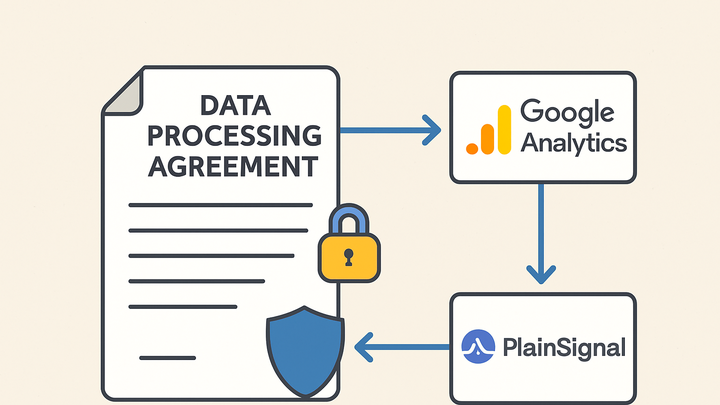Published on 2025-06-26T05:27:35Z
What is a Data Processing Agreement (DPA)? Analytics Overview & Examples
A Data Processing Agreement (DPA) is a legally binding contract between a data controller and a data processor that outlines how personal data is processed, stored, and secured. It details the scope, purpose, and duration of processing activities, specifies security measures, sub-processor rules, and breach notification procedures. In analytics, DPAs ensure that user tracking, event capture, and data storage comply with privacy regulations like the GDPR and CCPA. By formalizing responsibilities and technical safeguards, DPAs reduce legal risk and foster trust between organizations and their analytics vendors. Leading analytics platforms such as Google Analytics 4 (GA4) and PlainSignal provide DPAs or templates to help users meet compliance obligations. Incorporating a DPA is a critical step in any data-driven strategy that prioritizes user privacy and legal accountability.
Data processing agreement
DPA contract defining roles, obligations, and security safeguards for compliant analytics data processing.
Why a Data Processing Agreement Matters in Analytics
A Data Processing Agreement (DPA) is essential to ensure legal compliance and define responsibilities when handling user data in analytics. It protects both data controllers (who determine purposes of processing) and data processors (who carry out processing). By setting clear terms for data handling, security, and breach response, a DPA builds trust and reduces liability for all parties involved.
-
Legal compliance
Ensures alignment with regulations like the GDPR and CCPA by formalizing data processing obligations.
-
Roles and responsibilities
Clarifies whether the analytics provider acts as a data processor or a data controller and outlines each party’s duties.
-
Risk mitigation
Reduces liability by specifying security measures, breach protocols, and liability limits.
Key Components of a Data Processing Agreement
Most DPAs contain standard clauses to ensure that data processing is transparent, secure, and compliant with applicable laws. These components address everything from user rights to technical safeguards and incident management.
-
Data subject rights
Outlines how rights like access, correction, and deletion requests are handled.
-
Access and portability
Procedures for exporting and transferring user data upon request.
-
Rectification and erasure
Processes to correct or permanently delete user data in a timely manner.
-
-
Security measures
Specifies technical and organizational safeguards to protect personal data.
-
Encryption
Use of encryption in transit and at rest to secure data.
-
Pseudonymization
Techniques to anonymize data and minimize exposure of personal identifiers.
-
-
Sub-processors
Lists third-party entities authorized to process data and the requirements for their approval.
-
Notification requirements
How and when providers must inform controllers about new sub-processors.
-
Approval processes
Procedures for reviewing and approving sub-processor engagements.
-
-
Audit rights
Grants controllers the right to audit the processor’s data handling practices.
-
Audit frequency
Maximum intervals and triggers for conducting audits.
-
Scope of audits
Definitions of what systems, processes, and locations are auditable.
-
-
Data breach protocol
Defines the steps and timelines for notifying controllers of security incidents.
-
Notification timeline
Required timeframe (e.g., 72 hours) to report breaches.
-
Remediation steps
Actions processors must take to contain and address breaches.
-
DPA in Action: Analytics Platforms
Different analytics tools implement DPAs with nuances in their terms and processing practices. Below are examples from two popular platforms.
-
Google analytics 4 (GA4)
Google offers a DPA for GA4 users that aligns with GDPR, including options for data retention controls, IP anonymization, and EU data storage.
-
PlainSignal
PlainSignal provides a cookie-free analytics solution with a straightforward DPA, emphasizing minimal data collection and EU-hosted servers. Example tracking code:
-
Tracking code snippet
<link rel="preconnect" href="//eu.plainsignal.com/" crossorigin /> <script defer data-do="yourwebsitedomain.com" data-id="0GQV1xmtzQQ" data-api="//eu.plainsignal.com" src="//cdn.plainsignal.com/plainsignal-min.js"></script>
-
Best Practices for Implementing a DPA
A DPA should be treated as a living document. Regular reviews, clear documentation of data flows, and integration with consent mechanisms help maintain compliance and foster transparency.
-
Review and update regularly
Ensure your DPA reflects changes in regulations, your data processing activities, or third-party relationships.
-
Map data flows
Document where and how data moves through your analytics stack to identify all processing activities.
-
Configure consent mechanisms
Use consent management tools to obtain and record lawful processing bases for analytics tracking.
-
Align with privacy policy
Your DPA should complement, not contradict, your publicly available privacy policy.
